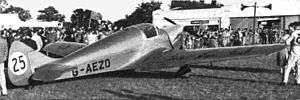Miles Whitney Straight
The Miles M.11 Whitney Straight was a 1930s British two-seat cabin monoplane with dual-controls.
| M.11 Whitney Straight | |
|---|---|
 | |
| M.11A Whitney Straight (G-AEZO), after finishing 2nd in the King's Cup Air Race at Hatfield, 11 September 1937 | |
| Role | sporting monoplane |
| Manufacturer | Miles Aircraft |
| Designer | Frederick George Miles |
| First flight | 14 May 1936 |
| Produced | 1936-1937 |
| Number built | 50 |
Design and development
The M.11 Whitney Straight was designed by F.G. Miles of Philips and Powis as the result of collaboration with Whitney Straight, a Grand Prix motor racing driver, aviator and businessman.[1][2] The aim was to provide comfortable accommodation for pilot, passenger and luggage in an enclosed 'side-by-side' cockpit. It was a low-wing monoplane, with fixed main undercarriage in aerodynamic fairings plus a fixed tailwheel. Construction was mainly of wood, with spruce frames and three-ply birch covering, and the wings had vacuum-operated split flaps. It was initially powered by a 130 hp (97 kW) de Havilland Gipsy Major I piston engine.[3]
.jpg)

Operational history
On 14 May 1936, the prototype (G-AECT), built by Philips and Powis (Miles Aircraft), first flew at Woodley Aerodrome, piloted by F.G. Miles. When production ended in 1937, 50 Whitney Straights had been built.[3][4]
On 28 June 1938, the M.11C (G-AEYI) crashed at Harefield, Berkshire, killing the test pilot, Wing Commander F.W. Stent. Modified Whitney Straights were also used as engine test beds and by Miles to test different flap designs. After the outbreak of World War II in 1939, the Air Ministry impressed 23 Whitney Straights into military service, for use as communications aircraft. Twenty-one of those served in the UK, one in India, and one in Egypt. One M.11A also served with the Fleet Air Arm from 1940 to 1943, and three with the Royal New Zealand Air Force.[3][4]
Between 1939 and 1943, a New Zealand machine piloted by Alan Pritchard was used for aerial seed sowing trials at Ninety Mile Beach and later spreading superphosphate. These trials were part of the experiments which led to the development of aerial topdressing, (see also Agricultural aircraft).[4]
Variants
Data from:British civil aircraft 1919-1972 Volume III[4]
- M.11
- M.11B
- the sole M.11B was powered by a 135 hp (101 kW) Amherst Villiers Maya I engine, adding 10 mph (9 kn; 16 km/h) to its maximum speed and 200 ft/min (1.0 m/s) to its rate of climb.
- M.11C
- the sole M.11C was powered by a 145 hp (108 kW) de Havilland Gipsy Major II engine driving a variable-pitch propeller.
Operators
- Royal Air Force
- Royal Navy
- Starways (G-AFGK)
Survivors
- G-AERV, cn307 in England, UK
- G-AFGK, cn509 at the Reynolds-Alberta Museum, Wetaskiwin, Alberta.
Specifications (M.11A)
Data from Miles Aircraft since 1925,[3] British Civil Aircraft 1919–1972: Volume III[4]
General characteristics
- Crew: 1
- Length: 25 ft (7.6 m)
- Wingspan: 35 ft 8 in (10.87 m)
- Height: 6 ft 6 in (1.98 m)
- Wing area: 187 sq ft (17.4 m2)
- Aspect ratio: 6.8
- Empty weight: 1,275 lb (578 kg)
- Gross weight: 1,896 lb (860 kg)
- Fuel capacity: 30 imp gal (36 US gal; 136 l)
- Powerplant: 1 × de Havilland Gipsy Major I 4-cylinder air-cooled inverted in-line piston engine, 130 hp (97 kW)
- Propellers: 2-bladed fixed-pitch propeller
Performance
- Maximum speed: 145 mph (233 km/h, 126 kn)
- Cruise speed: 130 mph (210 km/h, 110 kn)
- Range: 570 mi (920 km, 500 nmi) on 30 imp gal (36 US gal; 136 l) fuel
- Service ceiling: 18,500 ft (5,600 m)
- Rate of climb: 850 ft/min (4.3 m/s)
- Wing loading: 10.2 lb/sq ft (50 kg/m2)
Notes
- Tom Moulson (8 July 2014). The Millionaires' Squadron: The Remarkable Story of 601 Squadron and the Flying Sword. Pen and Sword. pp. 110–. ISBN 978-1-78346-339-8.
- Martin Bowman (26 June 2014). Lost Wings of WWI: Downed Airmen on the Western Front 1914-1918. Pen and Sword. pp. 303–. ISBN 978-1-4738-4226-7.
- Brown, Don L. (1970). Miles Aircraft since 1925 (1st ed.). London: Putnam & Company Ltd. pp. 121–128. ISBN 0-370-00127-3.
- Jackson, A. J. (1974). British civil aircraft 1919-1972 Volume III (2nd ed.). London: Putnam. pp. 62–65. ISBN 978-0-370-10014-2.
Further reading
| Wikimedia Commons has media related to Miles Whitney Straight. |
- Mondey, David. The Hamlyn Concise Guide to British Aircraft of World War II. Chancellor Press, 2002. ISBN 1-85152-668-4.